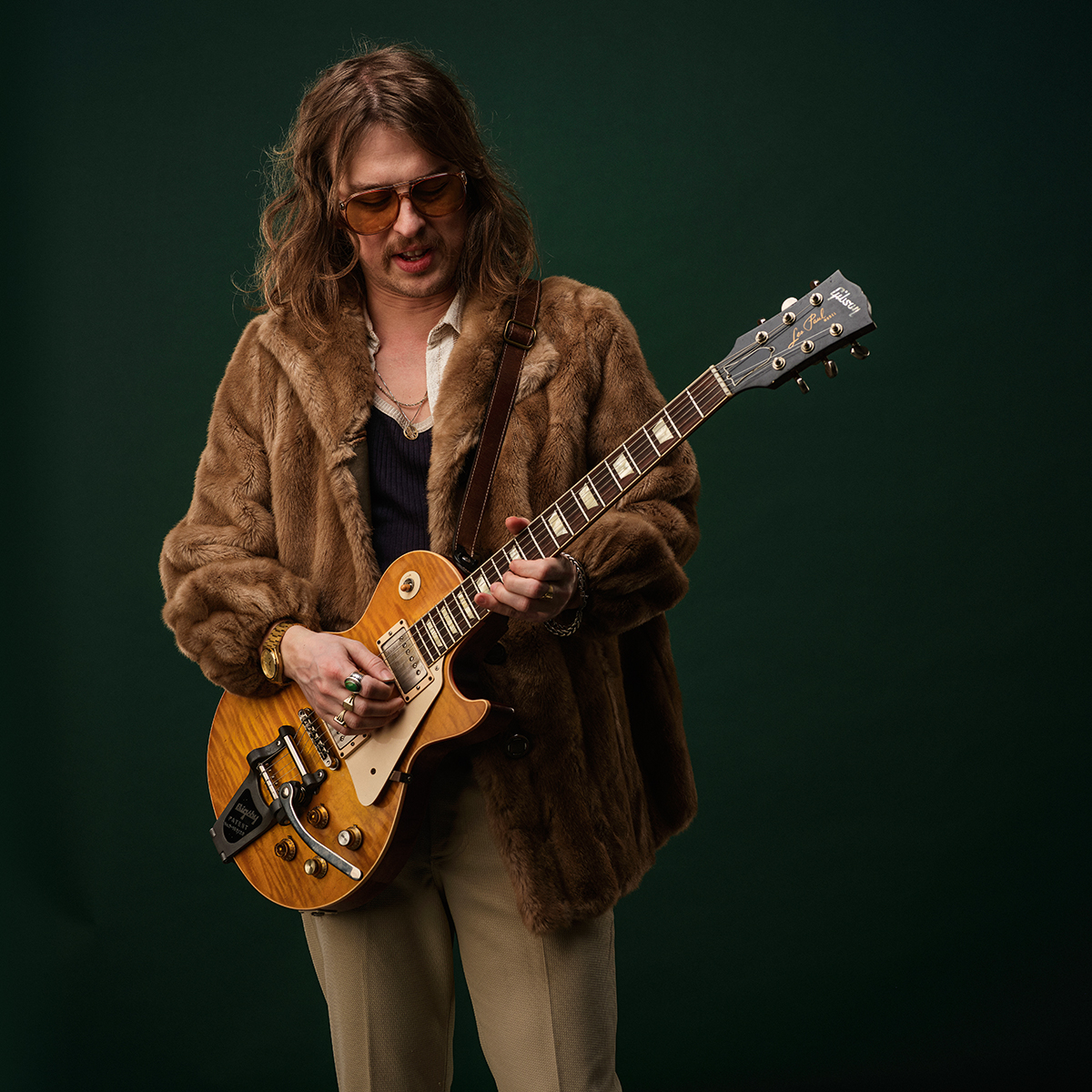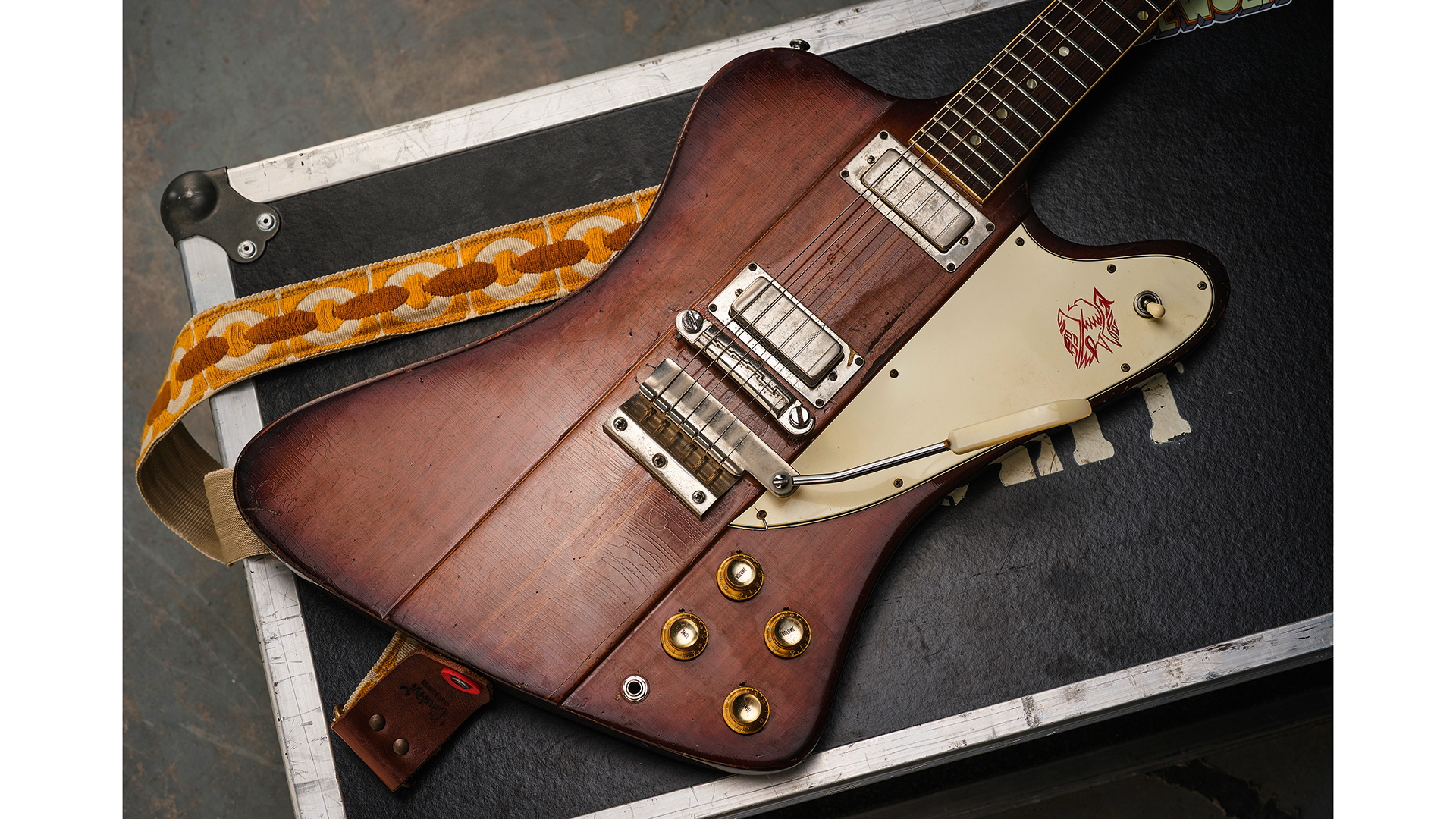
DeWolff are a three-piece band comprising brothers Pablo (guitar and vocals) and Luka van de Poel (drums) with keyboard player Robin Piso. The band takes its inspiration from the tie-dye days of the late 60s, and they pull it off, too.
The sheer enthusiasm for music that was made before any of them were born exudes from the stage, providing audiences with a mix of nostalgia and up-to-the-moment frenzied rock.
We caught up with Pablo as the dust was settling at the end of end of DeWolff’s recent UK tour, a few days after playing at the Omeara in London.
“I did have voice problems right around that time, but after all these years, I’ve kind of learned to just not worry about it,” he tells us. “Every time, the last show of the tour is always the best one…”
Not only were the 60s a driving force in DeWolff’s music, but the era influenced Pablo’s taste in guitars, too. A long-time Gibson Firebird fan, he turned up at Guitarist’s studios clutching not one but two examples of Ray Dietrich’s famous creation, as well as a pedalboard festooned with fuzz pedals…
Where did your journey with the guitar begin?
“I first started when I was eight years old. I was a massive Metallica fan; how that came to be I’m not entirely sure, but they were very popular at that time. Every hour or so there would be a Metallica video on the music channels on TV and, for some reason, I was attracted to the sound and the look and the guitars.
This teacher, I don’t want to discredit him, but he kind of turned me off guitar playing. For some reason he thought it was a good idea to teach a nine-year-old metal kid Old MacDonald…
“My dad was singing in a covers band and so every chance I had, when I had school vacations and stuff, I would come along with him to rehearsals and I was always mesmerised by the sound and the look of the guitar.
“Their guitar player had a Gibson Les Paul, so that must have imprinted something in my psyche. I was determined I wanted to play guitar. I had to save up for one myself, so for a full year I saved all my money and I bought a Squier Telecaster.”

Did you take lessons?
“Yes, I had to promise my parents that I was going to take lessons. So I took guitar ones and I was this Metallica kid, but my guitar teacher wanted me to read music, like Old MacDonald Had A Farm, stuff like that. I was not interested at all, but I was also a very polite kid so I just kind of played along.
“This teacher, I don’t want to discredit him, but he kind of turned me off guitar playing. For some reason he thought it was a good idea to teach a nine-year-old metal kid Old MacDonald…!
“So, for a while, I took a lot more interest in skateboarding than guitar playing… until I discovered Nirvana when I was 11. [With] Metallica it was kind of like, ‘I can’t really play this stuff, it’s pretty technically advanced,’ but Nirvana was something that I could grasp. I figured out how to play Smells Like Teen Spirit and, of course, as a kid it gives you so much satisfaction to be able to play a song that you love. I think that’s when I regained my passion for guitar playing, thanks to Nirvana.”

When did your love of 60s music begin?
“When I was 13 my dad bought me a Jimi Hendrix compilation CD. He grew up in the ’80s so he never experienced the music that came from the ’60s [first hand]. He didn’t know who Jimi Hendrix was, he just knew that people called him the best guitar player of all time, so he figured maybe I’d like it. At first I was like, ‘Whoa, this is weird music…’
“But I played the CD over and over and over, until all of a sudden, it clicked. I heard Voodoo Child (Slight Return) and I was like, ‘Wow, this is awesome.’ That was basically my gateway to ‘old music’. From there on, I discovered Cream and The Doors and Pink Floyd and The Beatles and The Rolling Stones. This all happened when I was 13 or 14 years old, and that was basically the start of everything for me.”
Did you start playing in bands soon afterwards?
“I formed my first band when I was 12, right after I learned to play a couple of Nirvana songs. We played a Smashing Pumpkins song and also something that I think was the first song I ever wrote. We started out as a grunge thing, but when I discovered Hendrix we started shifting more toward rock ’n’ roll.
“AC/DC was a big influence, too. By the time I was 14 or 15 we were playing some pretty big festivals here in the Netherlands, and when I was 16 I started my second band – and that was DeWolff.”

I formed my first band when I was 12, right after I learned to play a couple of Nirvana songs
You’ve gone from that first Squier Telecaster to Gibson Firebirds. What came in between?
“My second guitar was an Epiphone Les Paul Custom. That was because of Jimmy Page. Then I was really influenced by Rory Gallagher and so I needed a Strat. I saved up for a Mexican Strat that I still have somewhere. Then, because of Eric Clapton on the Cream farewell show at the Royal Albert Hall, I saw an ES-335 and I was mesmerised by the beauty of that guitar, but I could never afford a Gibson.
“So I bought a Samick 335 and that’s what I used on the first DeWolff EP. Then I got an endorsement with Danelectro and so I played them for a good while. They sounded really good, but they weren’t very comfortable guitars. So that’s when I bought the Firebird reissue.”

And since then you’ve added a vintage Firebird to your live setup. Tell us about it.
“Yeah, I bought the reissue secondhand and I played it on every show and almost every recording for years and years and years, so it looks very beat-up, like an old one. The Firebird is like an extension of my body and so I figured I’m a Firebird guy. It’s also kind of a unique guitar.
“The Firebird [reissue] I had played for so many years is a good guitar, but it’s not a great guitar because it has almost no sustain. And, I don’t know, there’s just some things about it that make it a little hard to play. So then I figured if I want to be the Firebird guy, I gotta go for a vintage one, but they’re always super expensive.
“I met up with a friend who’s a vintage guitar dealer and he had this ’65 Firebird III hanging on the wall. I played it and, even acoustically, it was one of the best guitars I’d ever played. The bottom half had broken off at some point and the headstock had broken off at some point, so it wasn’t a valuable guitar. But he didn’t want to sell it because it was his favourite guitar.”
“Some weeks later, I dreamed about it and after that experience I was like, ‘Oh my God, that’s the Holy Grail!’ After that my friend got a Firebird VII in the shop and he said to me, ‘Hey, isn’t this something for you?’ I was like, ‘No, man. What if you keep the Firebird VII and sell me the III?’
“A couple of days later, he was like, ‘Pablo, I’ll think about it…’ Fast forward a couple of days later: ‘All right, let’s do it!’ I had to promise that if I ever sell it I’ll give him the first option. But yeah, I finally have my dream guitar.”

There’s a bit of a mystery with the non-reverse headstock, isn’t there?
“Yeah, there are two scenarios. The first would be that Gibson was already well into transitioning to the non‑reverse Firebirds and they put a non-reverse headstock on it. The other scenario is that the headstock broke on the way to the first dealer and they sent it back and, for some reason, they put on a left-handed headstock.
“There’s a photo from the ’70s of a guy in quite a famous Dutch band playing this guitar and it already had this headstock on it. Why I think it happened on the way to the dealer is because if I was a customer in the early ’70s and my headstock broke, I would take it to a luthier and I wouldn’t be okay with that luthier putting a left-handed headstock on my right-handed guitar.
“I would be like, ‘No, you gotta fix it properly.’ Whereas if they sent it back to Gibson, and Gibson does it, maybe it’s like, ‘Well, I guess it’s okay then.’”
You have three separate fuzz pedals on your ’board – the Jen Tone Bender and Isle Of Tone’s Haze 65 and Luxe 64. How did you become such a fan of fuzz?
“It started a long time ago, actually. When I got into Hendrix I was too young to understand how he got his sound. I just saw the guitar and amps and I thought that was it. So that intrigued me, but then I discovered The Black Keys. I loved Dan Auerbach’s guitar tones on their early records and I discovered that he used fuzz to get his sound.
“So I looked on guitar forums to see what kind of fuzzes they were and I somehow got hold of an Analog Man Sun Face. Then, all of a sudden, I realised that you could clean it up and that’s what all the old guys were doing, which I had never really understood before. I just started experimenting with that.
“Then, coincidentally, a guy from Spain – [César de Vicente of] LofiMind Effects – sent me a message. He was like, ‘I’m making this fuzz and I want you to try it,’ and he sent it to me. I had an instant connection and was like, ‘Oh, this is great. I can dial in these sweet clean sounds but also just over the top, gritty distortion.’”
“Then that broke down and I borrowed an Isle Of Tone fuzz from someone and the Isle Of Tone guy saw a video of me and he sent me a couple of fuzzes. I’ve become good friends with Joe [Huber] from Isle Of Tone and that really got me into the fuzz game.”
What’s next for DeWolff?
“We’re gonna record a new album in May at Fame Studios in Alabama – the original studio where Wilson Pickett and Aretha Franklin recorded, and where the first Allman Brothers rehearsal ever took place. And then we’re going to spend a week at the Muscle Shoals Sound Studio, where Brown Sugar and Wild Horses were recorded and some Willie Nelson records, too. So that’s gonna be really exciting!”
- Live and Outta Sight 3 is out now via Electrosaurus.







